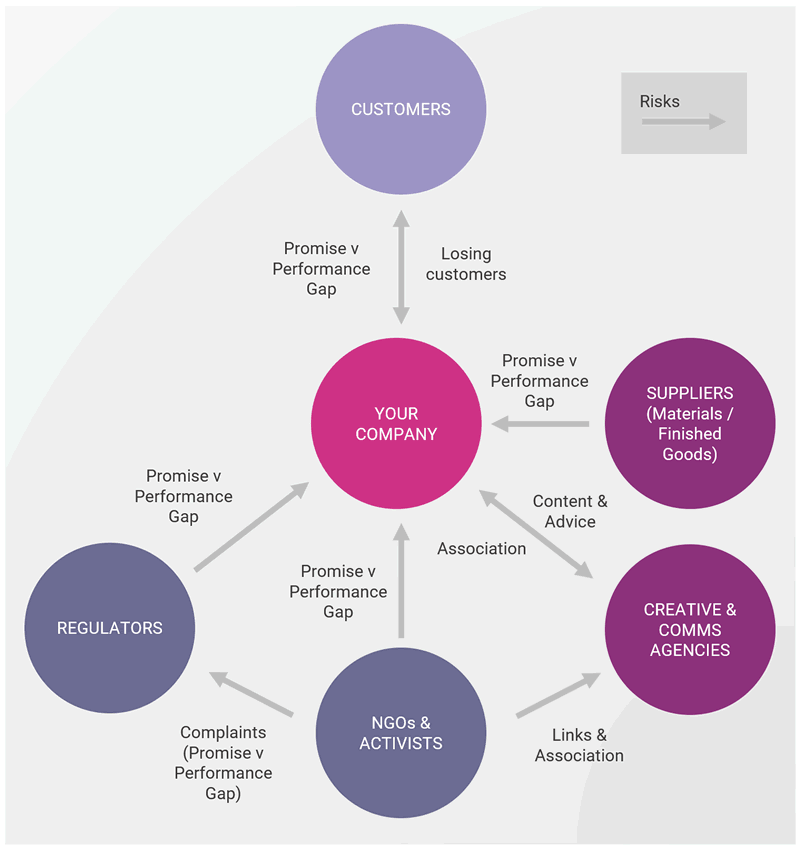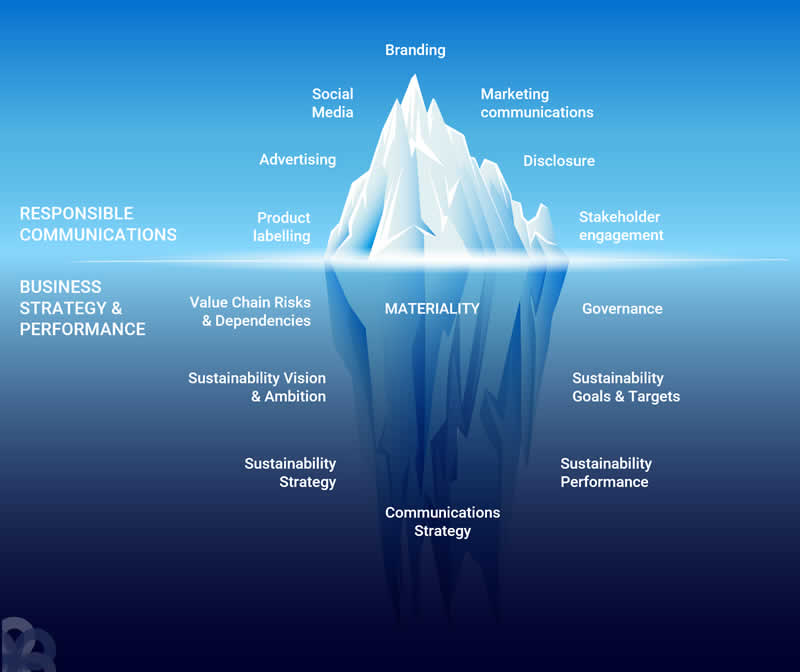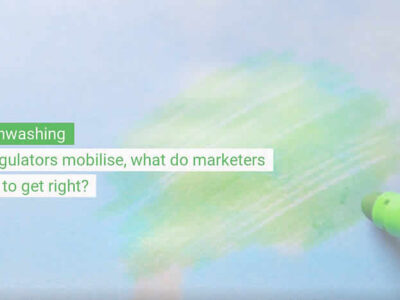‘the thing of which I have most fear is fear’.
Michel de Montaigne
Greenwashing – misleading communications on sustainability issues – can create various dimensions of risk, but these are often overlooked, and their implications are insufficiently examined.
While greenwashing may appear as simply irritating, it actually causes a range of harm and presents multiple business risks. Risks to the company which communicates it – but also risks to companies involved in creating it and those associated with it.
Greenwashing has traditionally been associated primarily with marketing and sales-related messages, but it is also being increasingly seen as something which can arise from strategic corporate communications and formal sustainability reporting and disclosure.
The nature of focus on what constitutes greenwash is also changing, moving from an assessment of whether specific claims or statements are clear, accurate and substantiated towards a wider assessment of claims, ambitions or implications for corporate performance within the context of the company as a whole.
What are the risks of greenwashing?
The most significant risks related to greenwashing can be placed into two distinct (but overlapping) areas.
Regulatory risk
Marketing and sales communications that break regulatory codes can result in adverts being banned and/or fines and the CMA (Competition and Markets Authority), the UK’s competition watchdog, has extensive and growing powers to censure companies for other types of misleading communications.
This is a prominent, but shorter-term risk – several of our customers have asked us to help them reduce risks specifically related to sustainability communications.
Reputation and brand risk
This is perhaps a much larger risk, as more is potentially at stake, and it can have longer-lived (albeit related) impacts than a regulatory breach.
Reputaton is an important asset and driver for many businesses and for the communications and creative agencies who support them with their messaging. However, the level of awareness about the risks appears to be low.
Reputation and brand often provide the greatest areas of opportunity and value in sustainability for companies. Reputation is a largely intangible attribute – but also potentially hugely valuable. It is often closely linked to sustainability performance. Greenwashing, or the perception of greenwashing, places this at risk.
Who are the important stakeholders for greenwashing risks?
The landscape is relatively complex as greenwashing risks can arise across different activities and areas in the value chain. They are summarised below.
Table 1. Greenwashing risk routes and relationships
| STAKEHOLDER | PRINCIPAL RELATIONSHIPS & INTERESTS |
| Regulators; CMA (UK), ASA (UK) EC (EU), FCC (US) | Protecting the interests of consumers and businesses, market integrity, focus on communications and behaviour of the ‘the company’. |
| Consumers / Customers (B2B) | Environmental and social performance of the company and the relative perceived merits of its products or services. |
| NGOs / activists | Pursuing their agendas, calling out examples of bad practice/perceived malfeasance in companies –their partners or suppliers. |
| Investors | ESG performance and risk to investment judgements for ‘the company’ which may already be held or is an investment prospect. |
| Company suppliers | Providing materials/labour/finished goods – a source of potential risk to their customers via their activities and material sourcing. |
| Creative/professional services suppliers to companies | Providing services (marketing, communications, advertising, sustainability). Source of potential risk to ‘the company’ in greenwashing through advice/content development. |
| The ‘company’ | Interested in protecting its reputation, avoiding regulatory action. Source of potential risk by association to creative/professional agencies, services companies and investors. |

Challenges for companies
Drawing out the implications for companies, managing potential greenwashing-related risks requires a focus on the company’s sustainability performance (across the value chain), which in turn is closely integrated with all communications related to sustainability and environmental issues. This extends to screening the performance of suppliers – including creative agencies which provide support and input to external communications.
Calculating the level of risk – as always with risk management, is complex. You can be hit with a fine or other regulatory action and that will highlight a bad news story that can affect your brand and reputation. The severity of this impact will depend upon a number of factors including:
- The perceived magnitude of the problem.
- How many people are affected.
- Duration of the problem (in turn related to…)
- The ability to take mitigating action – and demonstrably taking that action.
- Cumulative effects (has something similar happened before?).
These criteria imply the risk can be managed. However, any single issue, if perceived to be high impact by stakeholders, can be sufficient to cause a great deal of harm, and it’s these ‘long-tail’ risks, of low likelihood but high impact, that can be particularly damaging.
Challenges for the creative industries
Over the spring and summer, we’ve been talking to creative agencies, and many are aware of some of the reputational risks related to greenwashing. Like some of the other risk exposure routes outlined above, these involve both risk to the creative company and risk from the creative company.
These can include being involved in creating copy, content, and campaigns that breach rules, but also working for a company whose wider behaviours and performance may represent a risk to them by association.
A good example is provided by Clean Creatives, their:
‘pledge commits agencies, creatives, and strategists to refuse any future contracts with fossil fuel companies, trade associations, or front groups.’
Recently this has led to direct action protests against PR/creative giant Edelman’s ties to ExxonMobil (an Edelman customer).
So here we can see parts of the creative industry calling out perceived greenwashing and collaboration in greenwashing by their own.
Risk perception gaps
A risk perception gap is the distance between an informed and measured assessment of risk and the level of risk perceived/understood by the relevant parties/actors.
Through recent work and related discussions, we have seen at least three significant risk perception gaps.
1. Awareness and understanding
In general, the phenomenon of greenwashing is widely recognised and at one level understood to relate to the fundamental sustainability performance of a company (but see 2 below) – that companies without good sustainability performance are at risk when they seek to overclaim or make partial claims.
Less well recognised is that greenwashing can also be a risk for companies that are in principle ‘better performers’. A company can have good sustainability credentials but still produce communications which are not compliant with regulations related to greenwashing.
2. Focus
Many companies are aware of the risks related to greenwashing. However, anecdotally, we have found this is often at a generic level and frequently seen only through the lens of corporate and marketing communications – as opposed to the inherent sustainability management performance (and disclosure) of the organisation.
3. Responsibility
From our conversations with marketing, PR, and creative agencies, we have found that all are aware, at least in theory, of greenwashing and most are very keen to avoid it. However, a small number feel the risk lies with their client – that if the client signs off on copy/content which is not compliant then they have nothing to worry about. This I find a startling, short-sighted and short-term approach.
4. Materiality
Materiality (focusing on the issues that are important) is a core concept in sustainability (and greenwashing), but one that is often, if not poorly understood, certainly lacking in its observance and practice. To manage risk adequately, all important sustainability-related issues must be included in any assessment. If a company is making a claim regarding sustainability issues or performance, it is critical that all material issues are also carefully considered and assessed. In many cases these are not – see below.
The Clean Creatives example highlights a focus on carbon/climate-related issues. In the month that has seen the warmest global temperatures ever recorded, and severe heat in Europe, the US and beyond, it’s of course vital.
But if your assessment of association risk focuses only on carbon (and many we’ve seen only do this) then you are missing other material (priority) issues which also present possible risks.
To put it simply, if you screen a possible client based only on climate-based risks then how will you spot child labour, human rights, modern slavery, toxics, biodiversity, habitat loss, resource exploitation or other risks?
It’s somewhat unclear why the approach is so partial, it might be related to the maturity of understanding of sustainability issues, or the symptom of a lack of attention and resources available for this activity.
5. Reliance on standards
One of the ways to ensure communications on sustainability are responsible, and avoid greenwashing, is to use standards and certifications. The best ones provide robust third-party accreditation of performance.
But what happens if they are weak – or perceived as weak?
Following the public release (following a FOI request) of a 2020 Environment Agency report on agricultural pollution, the NGO River Action has claimed that the majority of the polluting farms in the study had Red Tractor certifications, and therefore that Red Tractor membership was not a good indicator of environmental performance. Red Tractor claims the report does not show this and contests the negative claims.
This sort of claim and counterclaim is not unusual. However, the twist in this case is that River Action has filed three complaints to the ASA (Advertising Standards Authority) claiming: “a strong body of evidence suggests that Red Tractor’s advertising, website and YouTube content is misleading consumers about the environmental standards with which its assurance scheme purports to guarantee compliance.“
The implications of this can be interpreted in several ways. Firstly, that campaign groups will use any tools available – and anti-greenwashing powers are now sufficiently strong that they can be actively used to root out poor practices.
Secondly, a much wider implication relates to a reliance on standards. Advertisers are required to hold up-to-date and relevant evidence to support claims made. If a label such as Red Tractor fails to provide this function in the supply chain the value of the label moves from one of substantiation to one of greenwashing. So, if the ASA upholds the River Action complaint there will be consequences across the supply chain.
Managing greenwashing risks
No risk can ever be removed completely, but awareness coupled with action can be applied to manage and mitigate risks.
However, if we revisit our table exploring the routes to risk, we can look at the management responses available to companies and their suppliers.
Table 2. Possible greenwashing risk management responses
| RISK FROM | RISK TO | ROUTE / RISK | MITIGATION |
| Regulators | Company | Direct / Fines/regulatory action Indirect / Damage to brand reputation. | Improve material performance. Ensure claims match performance and meet codes. |
| Regulators | Creative/professional agencies/services | Direct / Fines/regulatory action (for own communications) Indirect / Damage to brand reputation (for work supplied). | Direct / Most risk to the company through divestment or access to/cost of capital. |
| Consumers | Company | Indirect / Risk through complaints to regulators Direct / customer boycotts Indirect / Damage to brand reputation. | Improve material performance. Ensure claims match performance and meet codes. |
| NGOs / activists | Company | Direct / Most risk to brand reputation via adverse media. | Improve material performance, genuinely manage issues. |
| NGOs / activists | Creative/professional agencies/services | Direct / Most risk to the company through divestment or access to/cost of capital. | Screen customers. |
| Investors | Company | Direct / Most risk to the company through divestment or access to/cost of capital. | Improve material performance. Accurate, transparent and material disclosure. |
| Company suppliers | Company | Direct potential risk from activities, finished goods and materials supplied. | Improve supply chain performance . Screen suppliers and performance manage. |
| Creative/professional services suppliers to companies | Company | Direct potential risk from creating greenwash advice or content. | Screen suppliers and performance manage. |
| Company | Creative/professional agencies/services | Indirect Risk from association. | Screen customers. Engage with and support customers. |
As can be seen, this simple analysis suggests two main areas of activity for risk management and mitigation, performance improvement (including compliant communications) and company screening.
Performance improvement
We’ve written at length about and sustainability issues and performance improvement (e.g. 2023 sustainable business trends and challenges – what to watch out for, and embedding sustainability in your business) as it’s the main purpose of the support we provide.
However, the list below provides a checklist of the key aspects that are required:
- Understand the strategic context – what are the actual risks and impacts of your business?
- Assess materiality.
- Develop a focus on the (material) issues that matter for your company and stakeholders.
- Develop long-term goals and targets for material issues/areas.
- Disclose progress and performance.
- Communicate and engage with stakeholders on what’s important and your progress – with credibility and transparency.
- Review – review and adjust your issues/focus and responses/performance.
Compliant communications
This article provides more in-depth on this topic. The key elements of responsible communications are to ensure that any copy or claims:
- Use precise language – avoid unjustified general claims, and be specific.
- Apply sound logic – the claim must be entirely correct and tell the whole story of a product/service. If it only relates to a part of the product/service, it must not mislead about the overall environmental impact.
- Supply good evidence – all of the claim (whether absolute or relative) must be backed with timely and relevant underlying evidence.
Conclusions – managing greenwashing risks
Fundamental performance management provides the foundations for managing greenwashing risks and producing responsible communications. However, it’s often not visible and greenwashing is frequently only addressed at the ‘surface level’ of external communications.
The Responsible Communications Iceberg illustrates how responsible communications rely upon underlying business approaches and performance. Building trust, credibility and authenticity requires these underlying structures and delivery.

Avoiding greenwash is both a strategic and tactical endeavour.
At the strategic level, without meaningful overall strategy and verifiable performance then companies have a very shaky foundation to be making any sustainability claims in the first place.
Tactically – as noted above, even companies that might in principle have good underlying strategies and performance can still fall foul of greenwashing regulators if they do not comply with relevant regulations and codes.
The two levels cannot be separated or ignored.
While all communication has inherent risk, the companies with the best awareness of what risks exist, where they might occur and takes a careful, compliant, and strategic approach to their identification and management is most likely to avoid being accused of greenwashing.


Can we help you?
We’ve worked with companies in the UK, Europe and
beyond to avoid greenwashing by developing responsible communications approaches, content and copy. Ranging from strategic corporate reporting and disclosure to brand guidelines or in-store packs, we can help you develop content that’s clear, accurate and substantiated.
Book a chat with one of our partners to explore how we might help you – there’s no obligation!



 Sustainable transition – waiting for the underpants gnomes?
Sustainable transition – waiting for the underpants gnomes?
Leave a Reply